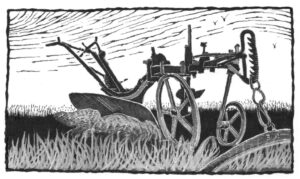“We shall not cease from exploration…” Eliot’s advisory for perception. 3
We have been talking of the past, and of the present, and of the hauntological membrane of experience between them. That membrane is of course unanchored, timeless, a hiatus between the twin towers of objective evidence and lived documented experience. Between the two lies a storied and fluid landscape populated by entities of our own making: from the more or less reasonable entities like folklore and oral history, through to the fractious and muddled boggarts of wishful thinking, ethnic assertions and populist pride. Magical pathworkings always instruct the querent to seek a guide through a spectral landscape − but just imagine if the guide you happen to meet is that QAnon shaman who made a less than inspiring appearance in the last article! Or someone like him, like one of those British National Party stalwarts following the party manual and reviving a lapsed folk tradition thinking they can gain traction for a revived ethnic nationalism. How many people have we each met, extolling the especial virtues of British/Celtic megalithic sites? The reason NE runs articles on megalithic and sacred sites overseas is not to encourage readers to worsen their carbon imbalance by flying off to see them, but to counter the myth, common in alternative archaeology as well as neo-paganism, that the British Isles are somehow particularly hallowed. We are not the only Isles of the Blest, and even if we were, getting on a hubristic high horse about it wouldn’t really maintain our halo.
Gangs roam any contested intellectual landscape, seeking associates and looking for any sign of an inquiring mind being tempted to settle for one thing or another, of inquiry becoming opinion becoming in-group identifier. Our revisionist antiquarian field was founded on the awareness that history is susceptible to more than one interpretation, and that questions need to be asked, and asked again. Even earth mysteries has evolved its orthodoxies and its lobby groups, united by notions of rightness; those of us involved in the field have all had to find a path through this zone where the guides we meet can be treacherous or sometimes just boringly intense and egotistical. We hope, of course, to arrive at a place where the view is, at least, less obscured. And the best journey to there is one where the views change sequentially as we travel, a vista opening here, a panorama there.
The phenomenological side of me, insofar as I understand the concept, rather likes a definition by Max van Manen, one that might particularly appeal to the alt-antiquarian, whose study is inevitably bound up with a sort of enquiring nostalgia: “Phenomenological method is driven by a pathos: being swept up in a spell of wonder about phenomena as they appear, show, present, or give themselves to us. In the encounter with the things and events of the world, phenomenology directs its gaze toward the regions where meanings and understandings originate, well up and percolate through the porous membranes of past sedimentations − then infuse, permeate, infect, touch, stir us, and exercise a formative and affective effect on our being”.1 This seems to speak to the awe which the Earth and the significant sites of our forebears arouse in us, and simultaneously the sadness that so much is already lost and more yet likely to be lost in our continuing exploitation and disregard of our planet and its needs. The pathos lies in, for me, the awful realisation that no one needs to discuss and excavate prehistory when the planetary infrastructure has other far more pressing priorities; and that we could, just could, be in the closing stages of antiquarianism and much else unless we (some more than others) lighten our load on the planet.
